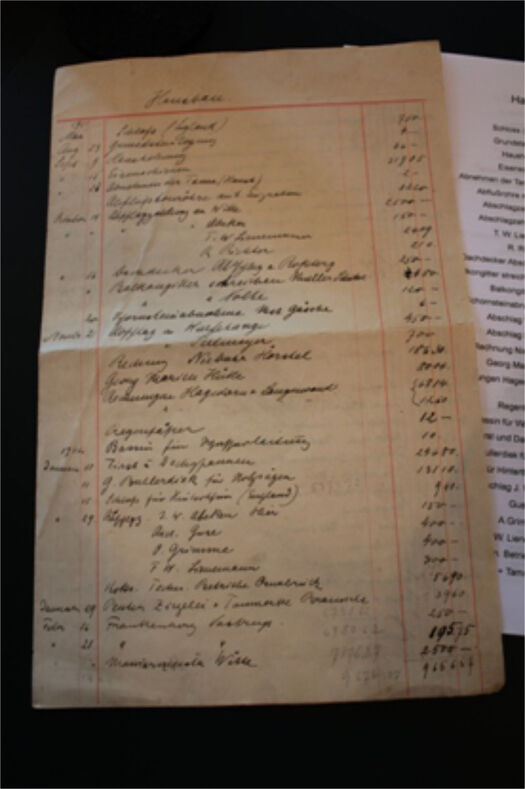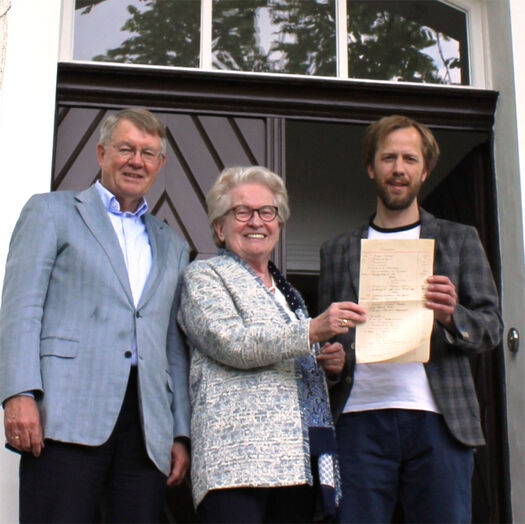Laying of the foundation stone: 4 marks


Archivist gives Bohnenkamp Foundation list with construction costs of Villa Hecker
Osnabrück, May 16, 2017
13,723.06 marks. This is how much it cost to build the first section of the villa that Franz Hecker (1870-1944) had built for himself on Osnabrück's Schölerberg between 1911 and 1915. The Osnabrück artist neatly listed the costs in a list. This had been in the possession of Marc Robbe since 2006. Now the antiquarian has handed over the list to the Friedel & Gisela Bohnenkamp Foundation, which thus has a document of Osnabrück's city history in its hands.
"It's comparatively low construction costs compared to the renovation of the villa," says Marc Robbe on the occasion of the handover of the list, in which Hecker has listed even such small amounts: On the left the date, in the middle the respective work steps or the responsible company and in the right column the costs. The first entry is from May 1911 - it is the lock Franz Hecker bought in England for his front door, cost: 7.50 marks. The next entry is the laying of the foundation stone in August of that year, for which the painter had to pay 4 marks. Among the contractors are some companies still known today, such as the company Glas-Deppen, to whom Hecker paid 142.44 marks for mirror glass in April 1915. The Frankenberg funeral home is also mentioned. The company, now located in Voxtrup, emerged in 1909 from a carpentry shop that Franz Hecker had commissioned to do some of the interior work on his house.
"Hecker called on artistically inclined craftsmen for the finishing touches," emphasizes Gisela Bohnenkamp. The donor mentions, for example, the painter's store Wilhelm Plogmann from Johannisstraße 25, which did not see itself as a classic craftsman's business, but rather as a company that was dedicated to artistic painting work and was also active, for example, at the Osnabrück theater.
"The house was Hecker's entry into a middle-class existence," Marc Robbe emphasizes. Franz Hecker had the villa built in three construction phases, and it was listed as a historical monument on July 1, 1983: First the main house (13,723.06 Marks) was built, from October 1913 the extension (17,957.00 Marks) and finally the veranda (2227.16 Marks). The designs came from Hecker himself, influenced by Heinrich Vogeler, who had designed the Barkenhoff in the artists' colony Worpswede, among others. The designs were implemented by the engineering firm Kempski & Mohr, Möserstraße 45. "I believe that Hecker did not need a bank for the financing," says Robbe, not only because of the construction in sections. Hecker apparently lived frugally: until he moved into his house on Schölerberg at the age of 42, the artist, who was born in Bersenbrück, lived with his mother in Osnabrück. In addition, at the time of building the house, he was already quite successful as a painter and was able to generate some income, for example, from the sale of prints of the etchings "Quartett" and "Unser Apfelbaum". "In the case of the two etchings, he had editions of 1000 and 1200," says Franz-Josef Hillebrandt, chairman of the board of trustees of the Bohnenkamp Foundation.
The list on Hecker's house construction comes from the estate of Ludwig Bätes (1892-1977). Hecker had been close friends with the Osnabrück writer and cultural historian until his death. Hecker died in November 1944 as a result of a bomb attack. In 2013, the Bohnenkamp Foundation acquired the property and extensively renovated it in close coordination with the Department of Historic Preservation. Since then, the villa has been home to the Friedel & Gisela Bohnenkamp Foundation.